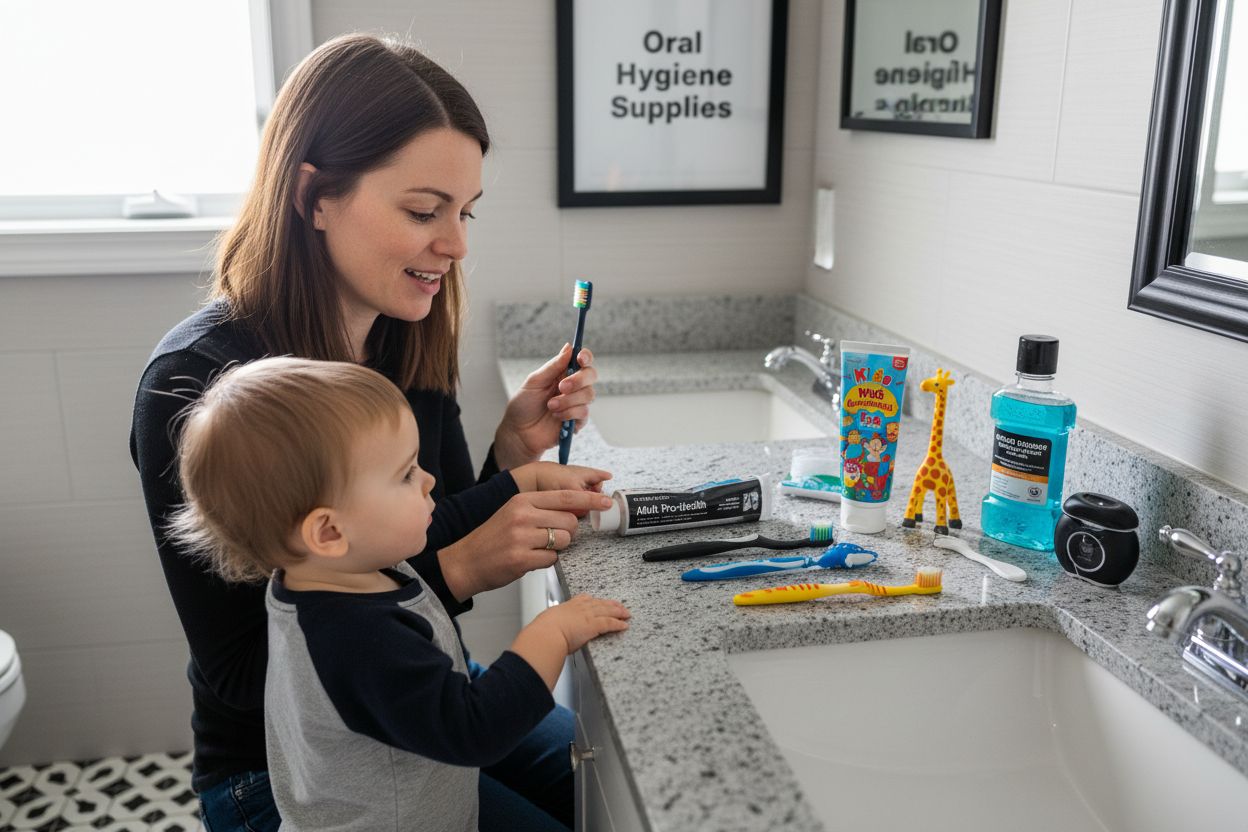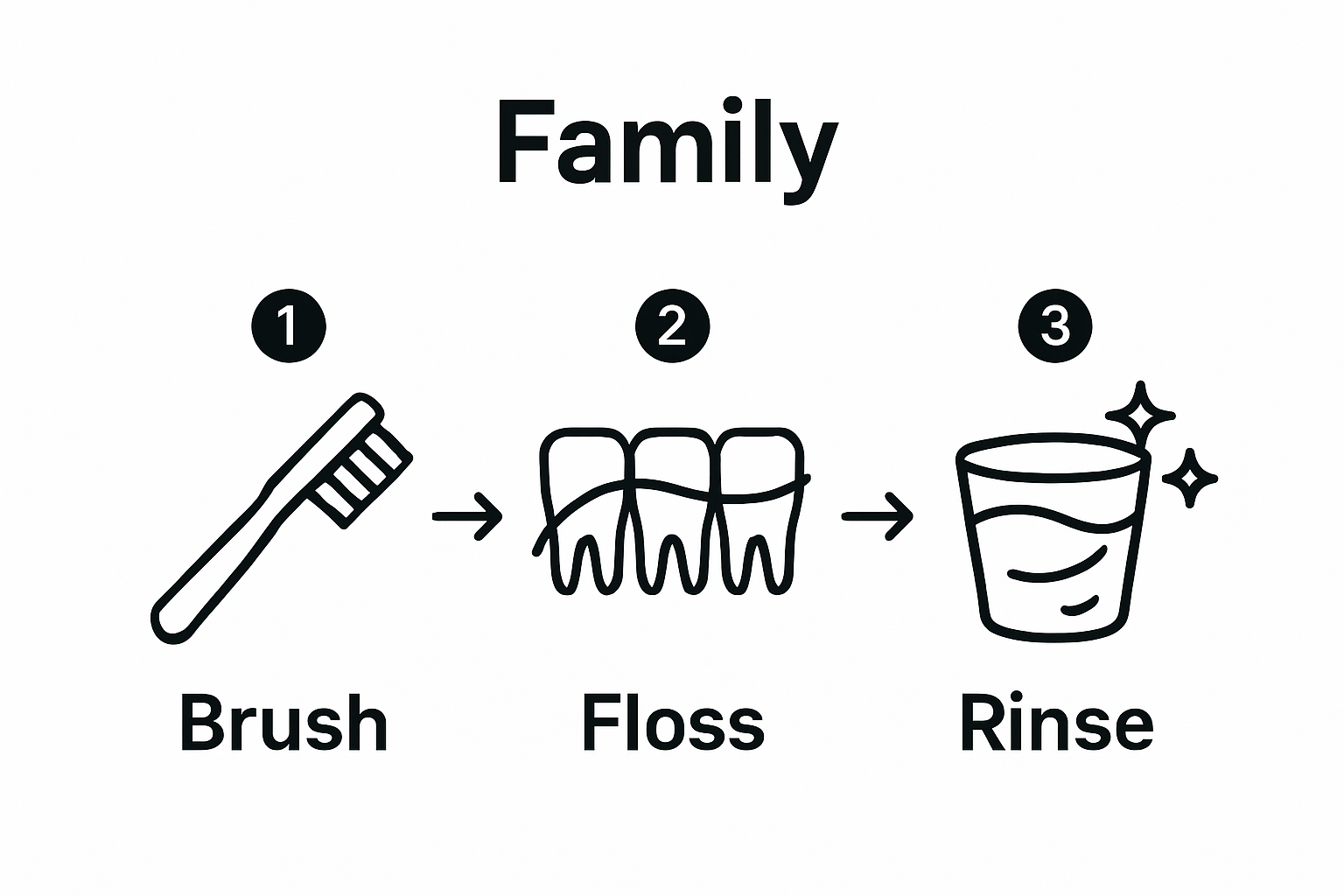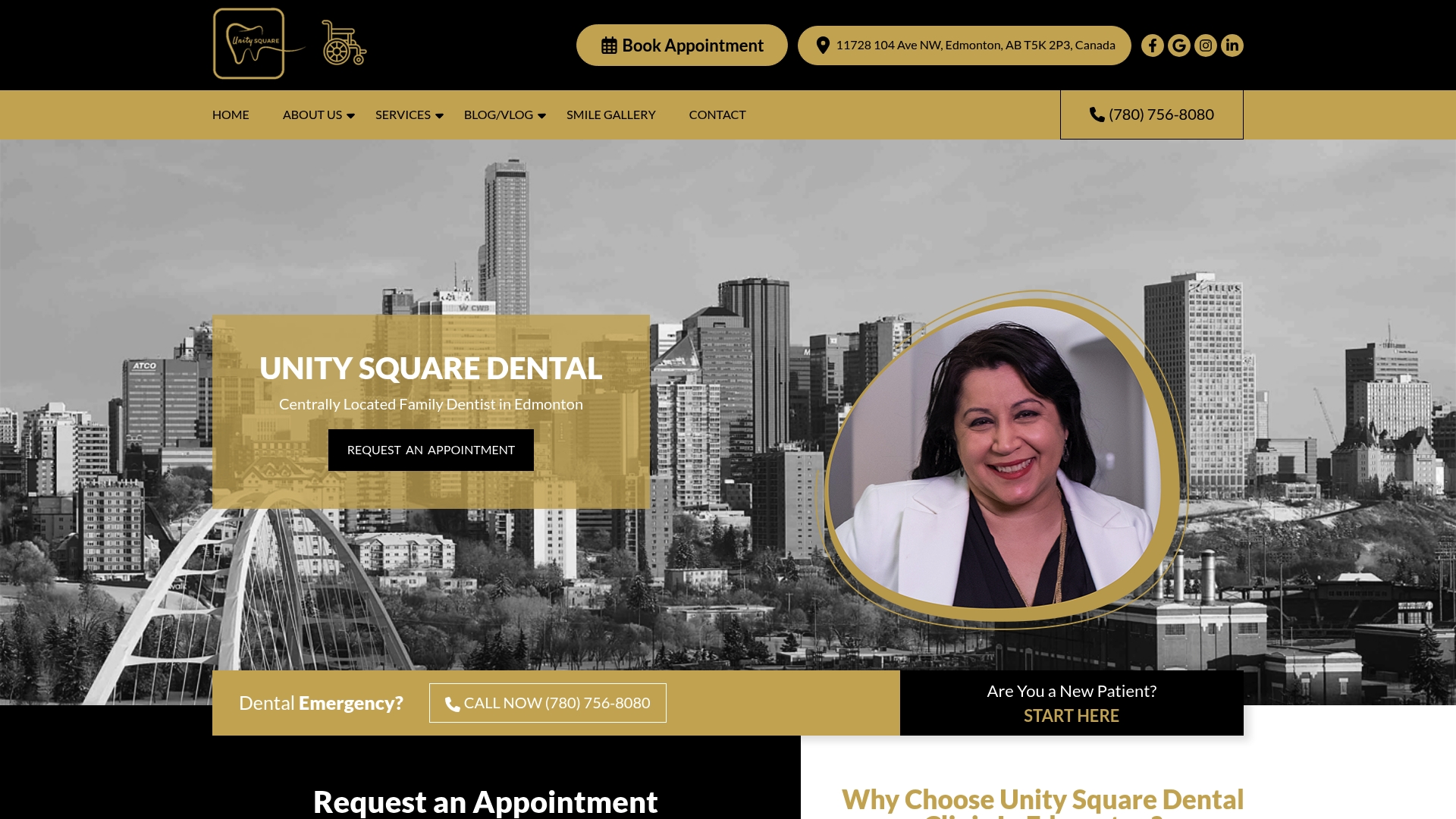
Setting up a family oral hygiene routine can feel overwhelming even before you start shopping for supplies. Yet more than 90 percent of adults have had cavities at some point despite access to toothbrushes, floss, and mouthwash. Most people think it’s all about brushing, but the real trick is building simple daily habits that practically run themselves.
Table of Contents
- Step 1: Gather Your Oral Hygiene Supplies
- Step 2: Establish A Daily Brushing Routine
- Step 3: Implement Flossing Techniques Effectively
- Step 4: Incorporate Mouthwash For Freshness
- Step 5: Schedule Regular Dental Check-ups
Quick Summary
| Key Point | Explanation |
|---|---|
| 1. Assemble quality oral hygiene supplies | Gather individual soft-bristled toothbrushes, fluoride toothpaste, floss, mouthwash, and a tongue cleaner for each family member. |
| 2. Establish a consistent brushing routine | Brush twice daily for at least two minutes using proper technique to ensure thorough cleaning for everyone. |
| 3. Master effective flossing techniques | Use 18 inches of floss to clean between teeth gently, forming a C-shape for optimal plaque removal. |
| 4. Incorporate mouthwash for added protection | Use an alcohol-free, fluoride mouthwash after brushing and flossing to help reduce bacteria and freshen breath. |
| 5. Schedule regular dental check-ups | Visit the dentist twice a year for comprehensive oral health assessments and to catch potential issues early. |
Step 1: Gather Your Oral Hygiene Supplies
Creating an effective oral hygiene routine starts with assembling the right tools and supplies. Before diving into your dental care process, you need a strategic collection of items that will help protect your family’s teeth and gums. The goal is to prepare a comprehensive oral care kit that makes daily cleaning efficient and thorough.
First, select high-quality tools that match each family member’s specific dental needs. For adults and children over three, choose a soft-bristled toothbrush that comfortably fits in the mouth and reaches all tooth surfaces. Learn more about selecting the perfect toothbrush for your family, which can make a significant difference in your daily oral care routine.
Your essential oral hygiene supplies should include:
- Soft to medium-bristled toothbrush (individual for each family member)
- Fluoride toothpaste appropriate for different age groups
- Dental floss or interdental cleaners
- Alcohol-free mouthwash
- Tongue cleaner or scraper
Consider the unique requirements of each family member. Young children might need smaller toothbrushes with fun designs to encourage regular brushing, while adults may prefer electric toothbrushes for more thorough cleaning. Fluoride toothpaste is crucial for everyone, but the concentration varies by age group. Children under three need a rice-grain sized amount of low-fluoride toothpaste, while older children and adults can use a pea-sized amount of standard fluoride toothpaste.
Purchase these supplies from local Edmonton pharmacies or dental supply stores. Replace toothbrushes every three to four months or sooner if bristles become frayed. The American Dental Association recommends regular replacement to maintain optimal cleaning effectiveness. By investing in quality oral hygiene supplies and replacing them consistently, you establish a strong foundation for your family’s dental health.
The table below provides a quick overview of the essential oral hygiene supplies needed for family dental care, including their role and age recommendations.
| Item | Purpose | Age Group Recommendation |
|---|---|---|
| Soft-bristled toothbrush | Cleans teeth and gums without causing damage | 3 years and up |
| Fluoride toothpaste | Prevents cavities and strengthens enamel | All ages (proper concentration per age) |
| Dental floss/interdental cleaner | Removes plaque and debris between teeth | Children with supervision, adults |
| Alcohol-free mouthwash | Reduces bacteria and freshens breath | Ages 6+ with supervision |
| Tongue cleaner/scraper | Removes bacteria and improves breath | Children and adults |
Step 2: Establish a Daily Brushing Routine
Establishing a consistent daily brushing routine transforms oral hygiene from a sporadic task into a reliable habit that protects your family’s dental health. The key is creating a structured approach that makes brushing feel natural and automatic for every family member. Learn more about optimal brushing frequency to refine your approach.
Your ideal brushing routine should focus on thoroughness and consistency. Aim to brush teeth twice daily – once in the morning after breakfast and once before bedtime. Each brushing session should last a minimum of two minutes, ensuring comprehensive cleaning of all tooth surfaces.
For children and adults alike, use gentle circular motions that cover the outer, inner, and chewing surfaces of every tooth.
Timing and technique matter significantly in your brushing routine. Position your toothbrush at a 45-degree angle to the gumline, which helps clean both teeth and gum margins effectively. Use soft, gentle strokes to prevent gum damage while removing plaque and food particles. Parents should supervise young children’s brushing, gradually teaching them proper technique as they develop motor skills.
Additional routine considerations for different age groups include:
- Toddlers (0-3 years): Parent-assisted brushing with a rice-grain sized toothpaste amount
- Children (3-6 years): Supervised brushing with pea-sized toothpaste, learning proper technique
- Older Children and Adults: Independent brushing with full fluoride toothpaste
Establish a predictable routine by linking tooth brushing to other daily activities. For instance, brush teeth immediately after morning shower or while waiting for coffee to brew. Create a family synchronization where everyone brushes together, turning it into a shared, positive experience.
 Use timers, smartphone apps, or musical cues to make two-minute brushing engaging, especially for children who might find the process monotonous.
Use timers, smartphone apps, or musical cues to make two-minute brushing engaging, especially for children who might find the process monotonous.
Successful routine implementation means everyone in the family brushes thoroughly twice daily without requiring constant reminders.
This table summarizes the recommended oral hygiene routines for each family member based on age, including brushing, flossing, and mouthwash use.
| Age Group | Brushing | Flossing | Mouthwash Use |
|---|---|---|---|
| Toddlers (0-3 yrs) | Parent-assisted, rice-grain of low-fluoride | Not required | Not recommended |
| Children (3-6 yrs) | Supervised, pea-sized toothpaste | With parental help | Child-safe, with supervision |
| Older Children/Teens | Independent, full fluoride toothpaste | Independent, with guidance | Standard mouthwash |
| Adults | Independent, full fluoride toothpaste | Daily, thorough flossing | Standard mouthwash |
| Braces/Special Needs | Electric toothbrush optional | Interdental or specialty tools | Consult dentist for type |
Step 3: Implement Flossing Techniques Effectively
Flossing represents a critical yet often overlooked component of comprehensive oral hygiene that reaches places your toothbrush cannot. While brushing cleans tooth surfaces, flossing removes trapped food particles and plaque between teeth and along the gumline, preventing potential cavities and gum disease. Learn more about specialized dental care techniques to complement your flossing routine.
Mastering proper flossing technique requires patience and precision. Begin with approximately 18 inches of dental floss, which provides enough clean section to move between each tooth without reusing contaminated segments. Wrap most of the floss around your middle fingers, leaving about one to two inches to work between teeth. Use your thumbs and forefingers to guide the floss gently and deliberately.
The American Dental Association recommends a specific approach to effective flossing. Slide the floss carefully between teeth using a rubbing motion, forming a soft C-shape around each tooth. Move the floss up and down against each tooth surface, ensuring you clean beneath the gumline without applying excessive pressure that might cause bleeding or tissue damage.
Different family members will require tailored flossing strategies:
- Children under 8: Require direct parental assistance and supervision
- Older children and teenagers: Can learn independent flossing with guidance
- Adults: Should focus on thorough, consistent daily flossing
- Individuals with braces or dental work: May need specialized flossing tools
Choose flossing tools that match your comfort and dental structure. Traditional string floss works well for most people, but alternatives like interdental brushes, water flossers, or floss picks can be excellent for those with dexterity challenges or specific dental configurations. Individuals with braces, wide tooth gaps, or sensitive gums might find these alternative tools more comfortable and effective.
Verify your flossing effectiveness by checking for clean, debris-free spaces between teeth and noting an absence of bleeding or inflammation. Consistent, gentle flossing should feel comfortable and leave your mouth feeling clean and refreshed. Aim to floss at least once daily, ideally before bedtime, to maximize oral hygiene benefits and prevent long-term dental issues.
Step 4: Incorporate Mouthwash for Freshness
Mouthwash serves as the final cornerstone in a comprehensive oral hygiene routine, providing an extra layer of protection and freshness beyond brushing and flossing. More than just a breath freshener, a quality mouthwash can help reduce bacteria, prevent plaque buildup, and support overall dental health. Explore advanced dental care techniques to complement your mouthwash routine effectively.
Selecting the right mouthwash requires understanding your specific oral health needs. Alcohol-free options work best for families, especially those with children or individuals with sensitive mouths. Look for mouthwashes containing fluoride for additional cavity protection, or specialized formulations targeting specific concerns like gum sensitivity or enamel strengthening.
The National Institute of Dental and Craniofacial Research recommends careful mouthwash selection based on individual dental requirements. For most families, an antiseptic mouthwash with fluoride provides the most comprehensive protection. Swish the recommended amount (typically 20 milliliters) thoroughly for 30 seconds, ensuring complete coverage of all mouth surfaces without swallowing.
Mouthwash usage varies by age and individual needs:
- Children under 6: Avoid mouthwash completely
- Children 6-12: Use under parental supervision with child-safe formulations
- Teenagers and Adults: Full independent use with standard antiseptic mouthwash
- Individuals with specific dental conditions: Consult dentist for specialized recommendations
Incorporate mouthwash into your daily routine by using it after brushing and flossing, preferably before bedtime. This final step helps eliminate any remaining bacteria, provides extended protection against tooth decay, and leaves a fresh, clean feeling. For maximum effectiveness, avoid eating or drinking for 30 minutes after mouthwash use, allowing the active ingredients to continue working.
Successful mouthwash integration means experiencing consistently fresh breath, reduced plaque buildup, and an overall clean mouth sensation. Pay attention to how your mouth feels after use – there should be a clean, refreshed feeling without excessive dryness or irritation. If you experience any discomfort, consider switching to a gentler formula or consulting with your dental professional to find the most suitable option for your family’s oral health needs.
Step 5: Schedule Regular Dental Check-ups
Regular dental check-ups form the foundation of long-term oral health, transforming preventive care from a reactive to a proactive approach. These appointments are not just about addressing existing issues but identifying potential problems before they escalate into complex, costly treatments. Discover the comprehensive benefits of professional dental care for Edmonton families.
Professional dental examinations should occur twice yearly, or every six months, for most family members. During these appointments, dentists perform comprehensive assessments that extend far beyond simple teeth cleaning. They examine tooth surfaces, check for early signs of decay, evaluate gum health, screen for oral cancer, and provide personalized guidance on improving your home oral hygiene routine.
The Canadian Dental Association recommends tailoring dental visit frequency to individual health needs. Some family members might require more frequent visits based on specific conditions like diabetes, pregnancy, or a history of periodontal disease. Children, in particular, benefit from early and consistent dental visits that help establish positive dental experiences and catch developmental issues early.
Preparing for a dental check-up involves several important considerations:
- Gather recent medical history information
- List current medications and health conditions
- Prepare questions about your oral health
- Bring dental insurance information
- Schedule appointments during low-stress times
When scheduling family dental appointments, coordinate timing to minimize disruption and potentially reduce overall healthcare costs. Many dental offices in Edmonton offer family scheduling options that allow multiple members to receive care during the same visit. This approach not only saves time but also helps normalize dental visits as a positive, shared family experience.
Verify the success of your dental check-up strategy by tracking consistent attendance, maintaining updated dental records, and observing improvements in overall oral health. Watch for reduced instances of cavities, healthier gum appearance, and dentist confirmation of effective home care practices. Remember that prevention through regular professional assessment is always more comfortable and cost-effective than treating advanced dental problems.

Transform Your Family’s Oral Hygiene With Unity Square Dental
Struggling to keep your family’s teeth healthy day after day? Establishing routines like proper brushing, flossing, and regular dental visits is only part of the journey. Many Edmonton families face frustration when home efforts are not enough, or when unique dental needs require professional insight and care. At Unity Square Dental, we use the same principles outlined in our latest article and combine them with advanced technology, gentle techniques, and a welcoming atmosphere to ensure your family’s smiles are protected for years to come.

Take charge of your family’s dental health today. Experience our personalized approach, explore our accessible services and modern amenities, and let our team help reinforce habits like prevention and early intervention. New patients can book an appointment online in just a few clicks for comprehensive, family-friendly care. Visit Unity Square Dental now and give your loved ones the confidence of lasting oral health. Slots fill quickly, so start your family’s brighter dental routine now.
Frequently Asked Questions
What are the essential supplies needed for a complete oral hygiene kit?
To create a comprehensive oral hygiene kit, include a soft to medium-bristled toothbrush for each family member, fluoride toothpaste suited for different ages, dental floss or interdental cleaners, an alcohol-free mouthwash, and a tongue cleaner or scraper.
How often should my family brush their teeth?
Family members should brush their teeth at least twice a day—once in the morning after breakfast and once before bedtime. Each session should last for a minimum of two minutes for thorough cleaning.
What is the correct technique for flossing?
Start with about 18 inches of dental floss, wrapping it around your middle fingers. Gently slide the floss between your teeth, forming a C-shape around each tooth to clean the surfaces while being careful not to apply excessive pressure that could cause gum bleeding.
Why is using mouthwash an important step in an oral hygiene routine?
Mouthwash helps reduce bacteria, prevents plaque buildup, and freshens breath, providing additional protection beyond brushing and flossing. It’s particularly effective when used after brushing and flossing, preferably before bedtime.
Recommended
- Dental Cleaning Frequency: Best Advice for Edmonton Families 2025 – Unity Square Dental
- Teeth Cleaning vs Whitening: Guide for Edmonton Families 2025 – Unity Square Dental
- Choosing the Right Toothbrush for Your Family’s Needs – Unity Square Dental
- Dental Cleaning Frequency: Best Advice for Edmonton Families 2025 – Unity Square Dental

